Windows 10 IoT开发:树莓派3+Azure实现云火警系统
防火是日常生活中非常重要的意识,如果你是一只恩爱狗,出门在外,家里被FFF团点了,那真是太惨(hao)了。如果你恰好有Windows 10的设备,比如Lumia,Surface,能及时收到火警是至(mei)关(sha)重(luan)要(yong)的。今天就教大家如何用Microsoft Azure公有云+Windows 10 IoT Core在树莓派上实现一个远程火警系统。
阅读这篇文章,你需要的前置知识:
Windows 10,UWP的基本开发能力
MVVM基础知识
ASP.NET MVC的基础知识
树莓派、GPIO及逻辑电路的基本知识(也就是大学里的计算机电路)
Azure公有云的使用经验
……当然,还要有对微软的信仰
一、设计原理
基本想法是,通过火焰传感器的输入信号,触发一个警报,把消息发送到Azure上的Notification Hub,这个服务是专门给Windows客户端推送消息的,然后就能在手机、平板、PC等各种Windows设备上弹出火警信息。
由于树莓派3上运行的是UWP程序,UWP还没有直接向Notification Hub发送消息的办法,所以得用一个ASP.NET网站帮它完成这件事。树莓派上的UWP程序先向ASP.NET网站发送请求,再由网站后台给Notification Hub发送消息,最终推送到客户端。
整个过程如下图所示:
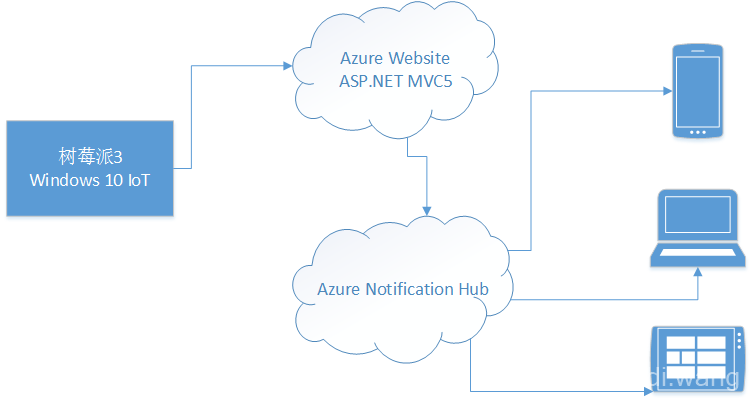
二、树莓派的配置
树莓派3必须用预览版的Windows 10 IoT,下载和安装步骤都在这里: http://ms-iot.github.io/content/en-US/win10/GetStarted/SetUpYourDeviceManually.htm
我用的是最新的Build 14295。如何在树莓派上装WIN10 IoT的教程满天飞,我就不啰嗦了,给几个实用连接:
格式化SD卡的工具: https://www.sdcard.org/downloads/formatter_4/eula_windows/index.html
Windows 10 IoT Core的发行说明: https://ms-iot.github.io/content/en-US/win10/ReleaseNotesInsiderPreview.htm
Powershell 远程管理的命令: http://ms-iot.github.io/content/en-US/win10/samples/PowerShell.htm
三、配件和物理连接
需要的配件有:
1. 蜂鸣器(低电平触发)
2. 三色LED(通用)
3. 火焰传感器(遇火焰输出低电平)
4. 面包板和杜邦线若干
5. 680欧电阻两个
为了避免广告嫌疑,购买链接不适合贴在博客文章里,大家可以自己去某宝搜。
连接方式如下图:
其中,LED的 红色输入 连接到GPIO 05, 绿色输入 连接到GPIO 06,火焰传感器的 DO输出 连到GPIO 19。为了简化,DO输出同时连接蜂鸣器的SIG端,这样就不用写代码触发蜂鸣器了。

三、Azure配置
打开Azure的新版portal( https://portal.azure.com ),新建一个Notification Hub,比如: RPi-FireAlarm-Notification , 记下名称和两个连接字符串,稍后要用。
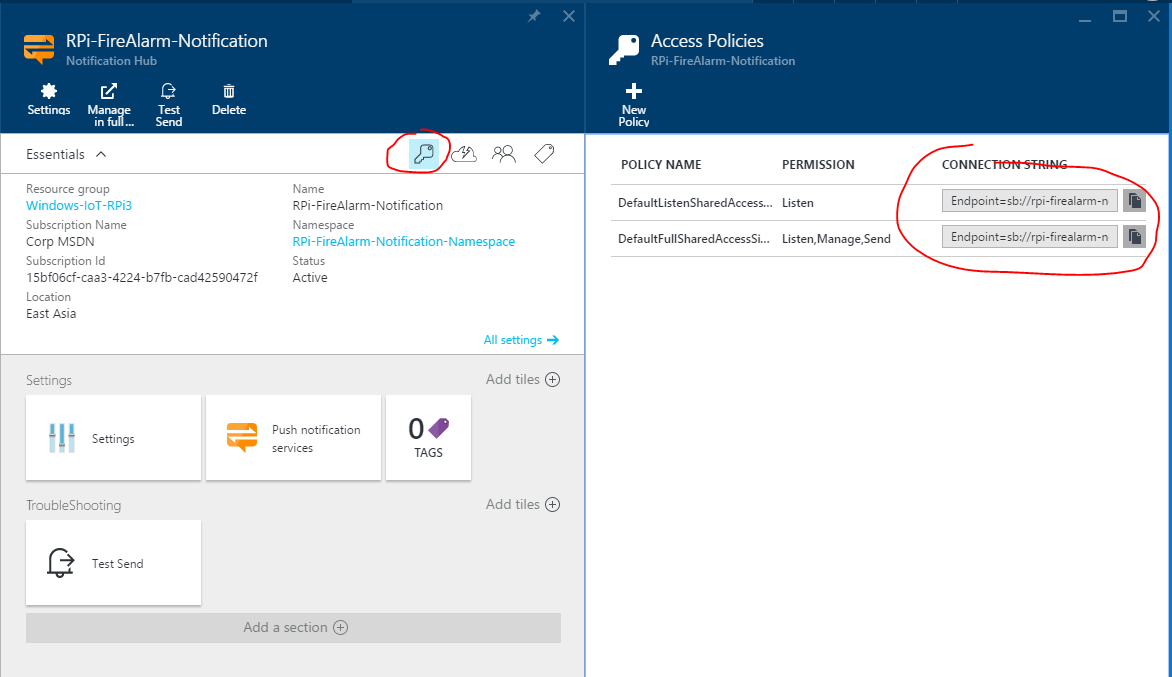
这个Notification Hub推送消息是要有key的,得去Windows开发者中心新建一个App然后拿它的推送消息的key。
位置在这里:

然后点 Live Serviecs Site的链接

从里面拿到 Application identity 和 Client secret 的信息。

回到Azure Notification Hub,在Settings页面,选择"Notification Services",然后选择"Windows",把刚才得到的SID和Key填进去保存。

四、接受通知的客户端
用VS2015新建一个UWP工程,比如AzureFireAlarm.NotificationClient, 关联到应用商店里刚刚建立的APP上,这一步很重要!!!关联的方法是在工程上点右键=>Store=>Associate App with the Store...
然后在App.xaml.cs里加入一个新方法:
private async Task InitNotificationsAsync() { var channel = await PushNotificationChannelManager.CreatePushNotificationChannelForApplicationAsync(); var hub = new NotificationHub("刚才Azure里的Notification Hub名称", "刚才Azure里的Listen连接字符串"); var result = await hub.RegisterNativeAsync(channel.Uri); //// Displays the registration ID so you know it was successful //if (result.RegistrationId != null) //{ // var dialog = new MessageDialog("Registration successful: " + result.RegistrationId); // dialog.Commands.Add(new UICommand("OK")); // await dialog.ShowAsync(); //} } 并且在OnLaunced方法最后调用一下:
protected override async void OnLaunched(LaunchActivatedEventArgs e) { ..... if (e.PrelaunchActivated == false) { ... Window.Current.Activate(); } await InitNotificationsAsync(); } 然后部署和启动一次这个APP,注意,这是客户端接受通知的APP,不是给树莓派用的,所以部署到自己的电脑或者手机上就好!
五、测试消息推送
回到Azure Notification Hub,点击“Test Send”,Platforms选Windows,Notification Type选Toast,然后点击Send
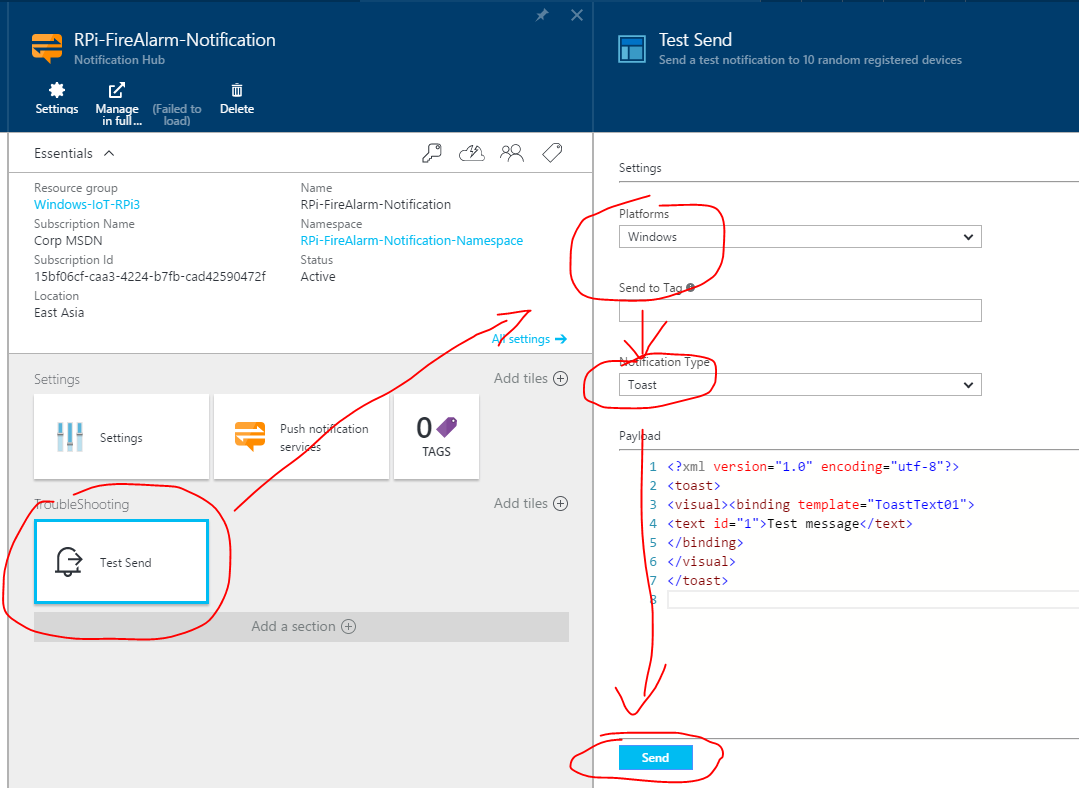
你的设备应该能收到测试消息:
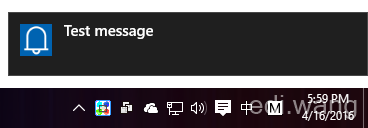
这就证明通知消息配置成功了。
六、ASP.NET网站
用VS新建一个ASP.NET MVC5网站,安装nuget包:Microsoft.Azure.NotificationHubs。
新建一个FireAlarmController:
public class FireAlarmController : Controller { public string HubName => "刚才Azure里的Notification Hub名称"; public string ConnectionString => "刚才Azure里的Listen,Manage,Send连接字符串"; public async Task<ActionResult> SendAlarm(bool isFire) { string msg = isFire ? "Oh, Fuck! There's a fucking fire!" : "Fire is out."; await SendNotificationAsync(msg); return Json(true, JsonRequestBehavior.AllowGet); } private async Task SendNotificationAsync(string message) { NotificationHubClient hub = NotificationHubClient .CreateClientFromConnectionString(ConnectionString, HubName); var toast = $@"<toast><visual><binding template=""ToastText01""><text id=""1"">{message}</text></binding></visual></toast>"; await hub.SendWindowsNativeNotificationAsync(toast); } } 主要就一个方法,SendAlarm,如果是true就发送火警消息:Oh, Fuck! There's a fucking fire!,如果是false就发送火已灭的消息:Fire is out.
运行这个ASP.NET网站,测试一下消息推送:
访问地址:
http://你的ASP.NET网站地址/FireAlarm/SendAlarm?isFire=true
应该能收到消息:
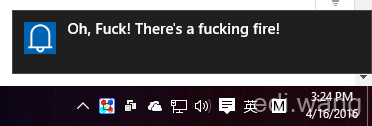
测试成功后,把网站部署到Azure上去。然后再测试一次,保证成功。
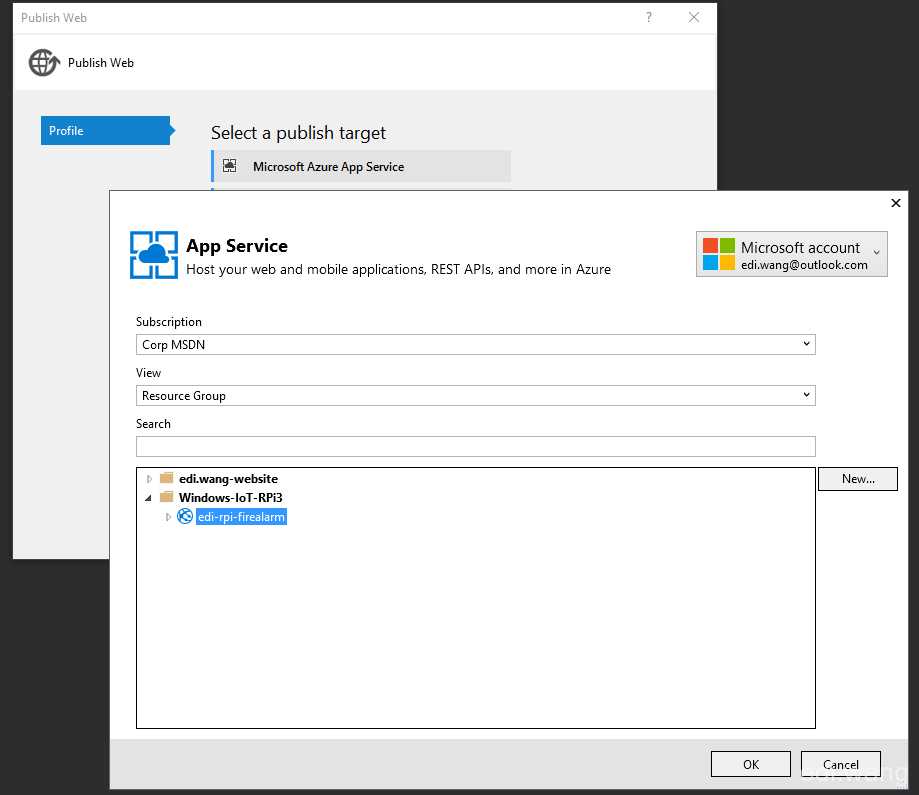
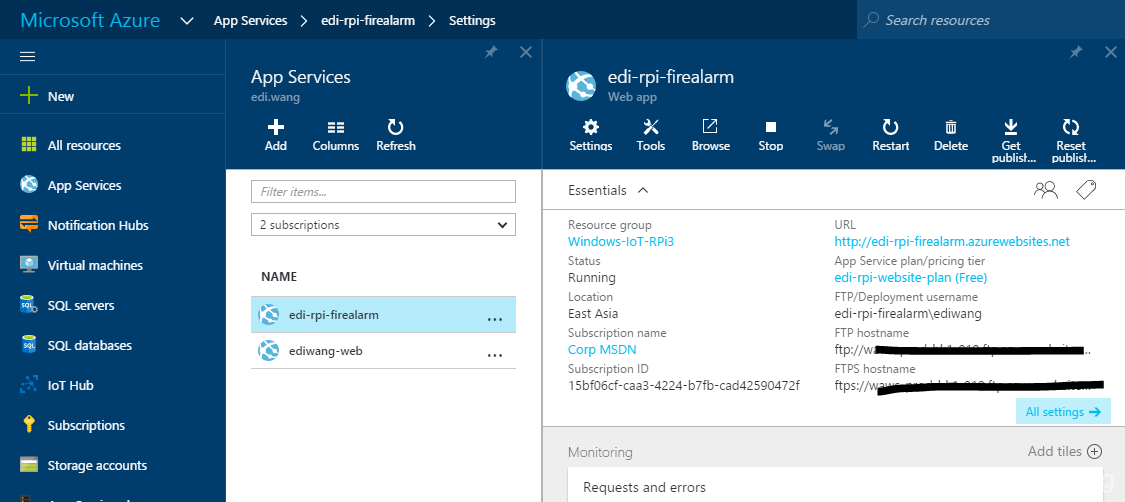
http://edi-rpi-firealarm.azurewebsites.net/FireAlarm/SendAlarm?isFire=true

七、树莓派端IoT应用:
用VS2015新建一个UWP工程,加入 Windows IoT Extensions for the UWP的引用。
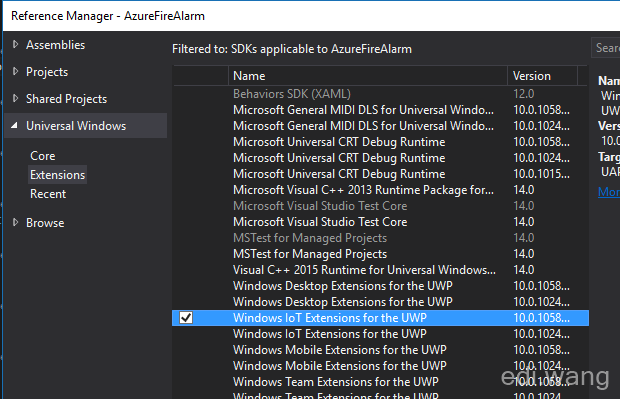
然后画个牛逼的界面(当然对于火警系统来说界面不是必须的):
<Page x:Class="AzureFireAlarm.MainPage" xmlns="http://schemas.microsoft.com/winfx/2006/xaml/presentation" xmlns:x="http://schemas.microsoft.com/winfx/2006/xaml" xmlns:local="using:AzureFireAlarm" xmlns:d="http://schemas.microsoft.com/expression/blend/2008" xmlns:mc="http://schemas.openxmlformats.org/markup-compatibility/2006" DataContext="{Binding Source={StaticResource Locator}, Path=Main}" mc:Ignorable="d"> <Grid Background="{ThemeResource ApplicationPageBackgroundThemeBrush}" Padding="12"> <Grid.RowDefinitions> <RowDefinition Height="Auto" /> <RowDefinition Height="*" /> </Grid.RowDefinitions> <Image Source="Assets/cloud-hero.png" Grid.Row="0" Height="80" HorizontalAlignment="Right" VerticalAlignment="Top" /> <StackPanel Grid.Row="0"> <TextBlock Text="Windows 10 IoT + Microsoft Azure" Style="{StaticResource SubtitleTextBlockStyle}" /> <TextBlock Text="Remote Fire Alarm" Style="{StaticResource SubheaderTextBlockStyle}" /> </StackPanel> <Grid Grid.Row="1" Margin="0,20,0,0"> <Image Source="Assets/Windows_Insiders_Flag.png" HorizontalAlignment="Right" Height="300" VerticalAlignment="Bottom" /> <Border BorderBrush="#CCC" BorderThickness="1" Margin="0,10,0,0" Padding="10"> <TextBlock TextWrapping="Wrap" Text="{Binding FireDetectionLog}" Foreground="#CCC" FontFamily="Consolas" /> </Border> </Grid> </Grid> </Page> 
主要逻辑在ViewModel里:
定义GPIO控制器和所有要用到的阵脚:
#region GPIO Settings public GpioController GpioController { get; } public GpioPin RedLEDPin { get; } public int RedLEDPinNumber => 5; public GpioPin GreenLEDPin { get; } public int GreenLEDPinNumber => 6; public GpioPin FirePin { get; } public int FirePinNumber => 19; #endregion 在树莓派屏幕上显示日志的字段:
#region Display Fields private string _fireDetectionLog; public string FireDetectionLog { get { return _fireDetectionLog; } set { _fireDetectionLog = value; RaisePropertyChanged(); } } #endregion 初始化元件和传感器:
public MainViewModel() { GpioController = GpioController.GetDefault(); if (null != GpioController) { // fire light RedLEDPin = GpioController.OpenPin(RedLEDPinNumber); RedLEDPin?.SetDriveMode(GpioPinDriveMode.Output); RedLEDPin?.Write(GpioPinValue.Low); // secure light GreenLEDPin = GpioController.OpenPin(GreenLEDPinNumber); GreenLEDPin?.SetDriveMode(GpioPinDriveMode.Output); GreenLEDPin?.Write(GpioPinValue.High); // fire detector FirePin = GpioController.OpenPin(FirePinNumber); if (null != FirePin) { FirePin.SetDriveMode(GpioPinDriveMode.Input); FirePin.ValueChanged += FirePinOnValueChanged; } } } 注意,绿色LED一开始就要输出高电平,以点亮,表示安全,没有明火。
火焰传感器事件:一旦遇到低电平,表示有明火,向Azure Website发送火警通知。检测不到火焰则发送安全通知。
private async void FirePinOnValueChanged(GpioPin sender, GpioPinValueChangedEventArgs args) { if (sender.Read() == GpioPinValue.Low) { await DispatcherHelper.UIDispatcher.RunAsync(CoreDispatcherPriority.Normal, () => { FireDetectionLog += "/nFire detected! Sending alarm to Azure."; }); // alarm buzz RedLEDPin.Write(GpioPinValue.High); GreenLEDPin?.Write(GpioPinValue.Low); await SendToastNotificationAsync(true); } else { await DispatcherHelper.UIDispatcher.RunAsync(CoreDispatcherPriority.Normal, () => { FireDetectionLog += "/nFire is killed! Sending alarm to Azure."; }); // shut down buzz RedLEDPin.Write(GpioPinValue.Low); GreenLEDPin?.Write(GpioPinValue.High); await SendToastNotificationAsync(false); } } 请求Azure Website的方法:
public async Task SendToastNotificationAsync(bool isFire) { using (HttpClient client = new HttpClient()) { string url = "http://edi-rpi-firealarm.azurewebsites.net/FireAlarm/SendAlarm?isFire=" + isFire; await client.GetAsync(url); Debug.WriteLine("{0} > Sending message: {1}", DateTime.Now, isFire); } } 八、运行效果:
有火焰时,红灯亮起,蜂鸣器启动,向Azure发送通知
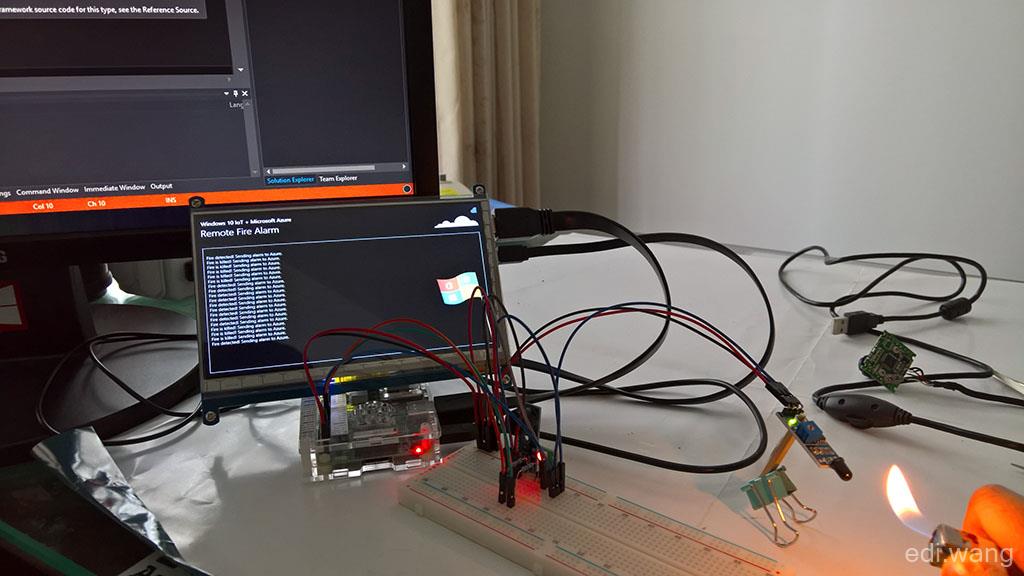
没有火焰时,绿灯亮起,向Azure发送火焰已灭的通知
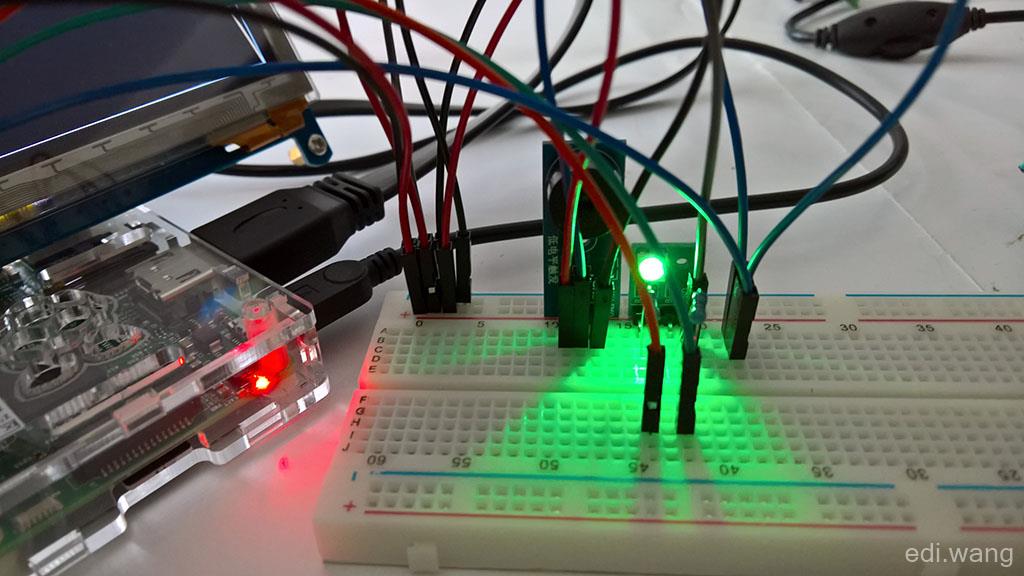
Windows 10 PC上的通知中心:
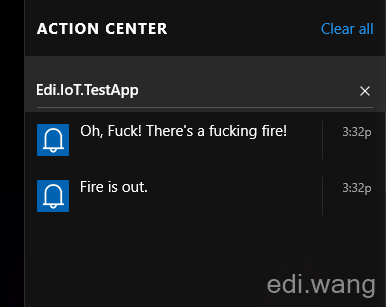
Windows 10 手机上的通知中心:
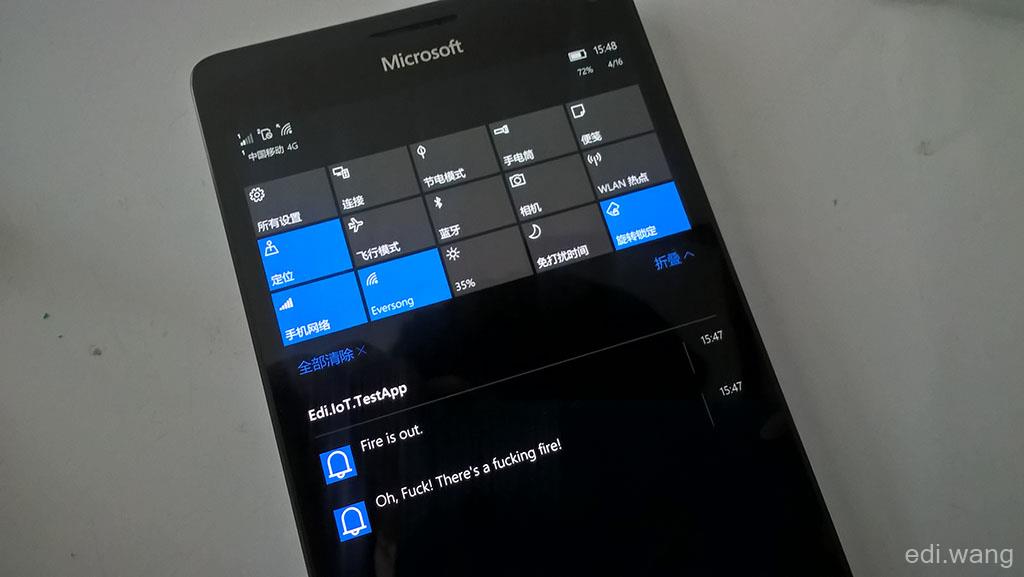
- 本文标签: schema http git 安全 微软 json Connection ECS message shell 网站 IDE HTML Powershell ask 2015 remote cat redis App 开发 core 下载 windows 广告 开发者 CTO list entity 文章 测试 tar UI 代码 value src 配件 web Region GitHub client ACE wget js 配置 管理 key build 博客 云 https 安装 NSA XML
- 版权声明: 本文为互联网转载文章,出处已在文章中说明(部分除外)。如果侵权,请联系本站长删除,谢谢。
- 本文海报: 生成海报一 生成海报二










![[HBLOG]公众号](https://www.liuhaihua.cn/img/qrcode_gzh.jpg)

